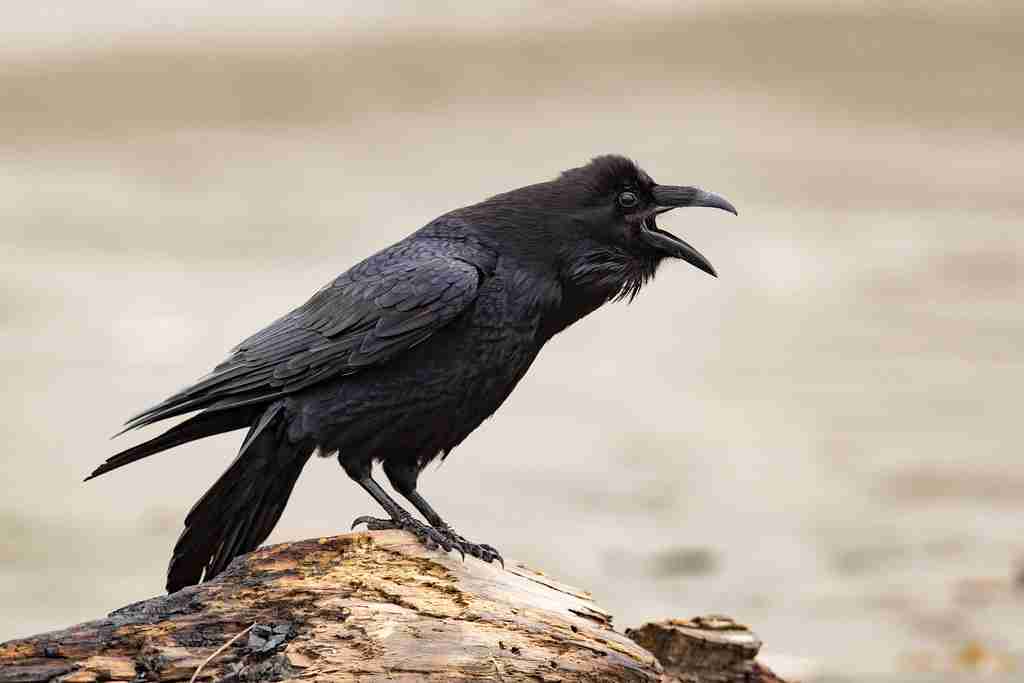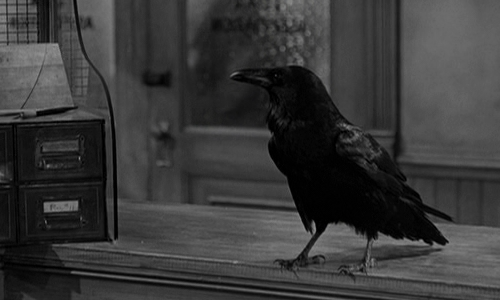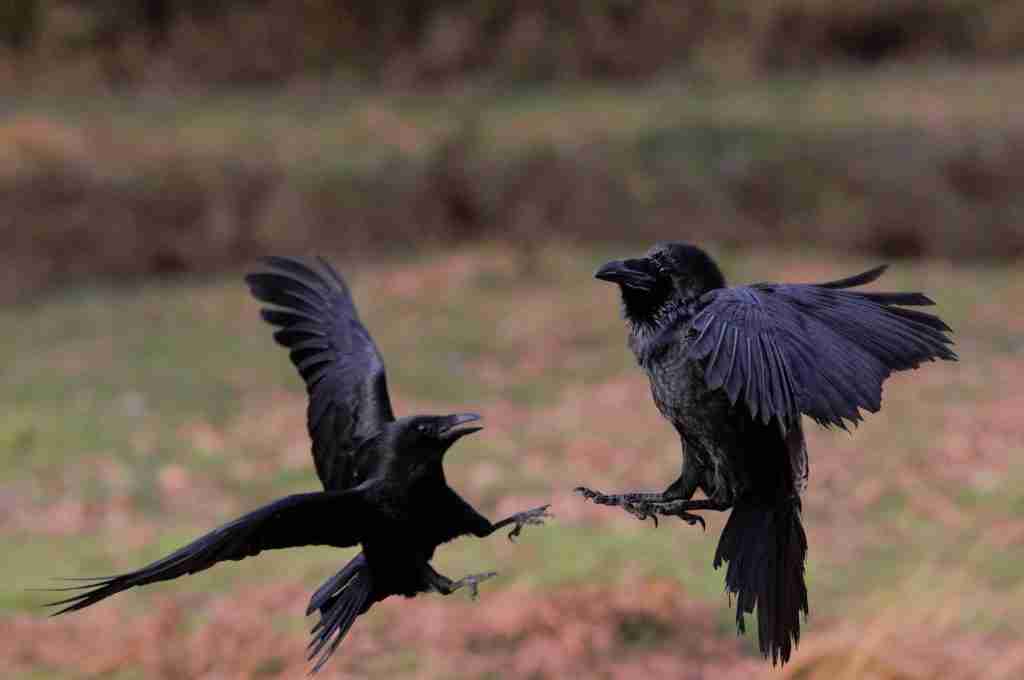23 Fun Facts About Ravens | Feathered Mystique
1. Ravens and Crows are the same species but differ in size and calls.
Crows and ravens, both from the Corvus genus, are distinct yet related. Ravens are bigger, with thicker bills and wedge-shaped tails, while crows are smaller, more social, and have curved tail ends.
A raven’s deep croak contrasts with a crow’s sharp caw. These differences help distinguish these intelligent, glossy black-feathered birds.
2. Ravens are known for their problem-solving skills and can use tools.
Ravens showcase remarkable intelligence, as evidenced by their ability to solve complex problems and use tools effectively, a skill observed in research by Kabadayi and Osvath.
In experiments, these birds adeptly selected the correct tools from a mix, even saving them for future use, demonstrating foresight and advanced reasoning abilities rarely seen in the wild.
3. A group of ravens is called a conspiracy or an unkindness.
A group of ravens is known as an unkindness or a conspiracy, reflecting their traditional association with ominous symbols. Often misunderstood, these gatherings can evoke fear, yet ravens are more than just bearers of bad omens.
They’re complex creatures, with their group names like unkindness, conspiracy, and constable hinting at their enigmatic nature in human folklore and perceptions.
4. The largest raven species are the Common and Thick-Billed Raven.

The Common and Thick-Billed Ravens are the largest in the Corvid family. The Thick-Billed Raven, from Africa, rivals the largest Common Ravens in size, often weighing more.
Common Ravens, widespread in the Northern Hemisphere, are large perching birds, averaging 63 cm in length. These species stand out in the diverse passerine order, showcasing significant size variations among their kind.
5. Ravens can mimic sounds, including human speech, and other animal calls.
Ravens are skilled mimics, capable of replicating a variety of sounds, including human speech and animal calls. Their complex vocal abilities allow them to imitate the deep tones of men or the higher pitches of women, especially in captivity.
In the wild, they cleverly mimic wolf and fox calls to access food from carcasses, showcasing their intelligence and adaptability.
6. Ravens are monogamous and often mate for life.
Ravens are known for their monogamous nature, often forming lifelong pair bonds. They usually start breeding between 2-4 years old, staying together year-round, and roosting close to each other.
These birds choose their partners carefully, as finding a new mate is rare if the bond breaks. In some cases, ravens mate for life, remaining together until one of them passes away.
7. Ravens can plan for the future, a trait seen in great apes and humans.
Ravens demonstrate the rare ability to plan for the future, a trait once thought unique to humans and great apes. Research from Lund University shows these intelligent birds can think ahead, store food for later, and use tools effectively.
Their excellent memory aids in caching food and using objects to solve problems, highlighting their advanced cognitive capabilities.
8. Rare white ravens are found near Qualicum Beach, Canada.
Qualicum Beach in Canada is known for its rare white ravens, caused by a genetic condition called leucism, which reduces pigmentation. These unique birds, born infrequently, are part of local legend and natural wonder.
A pair of white ravens have been producing offspring for over a decade, though they face challenges in survival and breeding compared to typical black ravens.
9. In Norse mythology, Odin is linked with two ravens acting as his eyes and ears.
In Norse mythology, Odin, the chief god, had two ravens, Huginn (thought) and Muninn (memory), acting as his eyes and ears. These birds flew daily across Midgard, gathering information and reporting back to Odin.
They symbolized Odin’s quest for knowledge and his connection to the world, with their presence indicating his watchful gaze over the realm of men.
10. To communicate, Ravens use gestures, like pointing with their beaks.
Ravens communicate using gestures, a sign of their intelligence. In a study at Cumberland Wildpark in Austria, researchers observed ravens using their beaks-like hands to show and offer objects to each other, especially to members of the opposite sex.
These gestures, involving items like moss and twigs, often led to interactions such as bill touching or joint manipulation of the objects, enhancing their social bonds.
11. Ravens are known for their large and complex nests.
Ravens build large, complex nests, often reusing and enlarging them each year, sometimes reaching four feet across. They line their nests with fur for insulation and egg incubation.
Females lay three to seven eggs, incubated by both parents for up to 21 days. Chicks remain in the nest for four weeks before flying off. Ravens even use rocks to protect their nests from intruders.
12. The Tower of London’s fate is tied to its six ravens, protected by royal decree.
Legend holds that the Tower of London and the kingdom will fall if its six ravens leave. Currently, these ravens, named Jubilee, Harris, Poppy, Georgie, Edgar, and Branwen, are cared for by the Ravenmaster.
King Charles II, heeding a prophecy, first ordered their protection, overruling his astronomer John Flamsteed’s objections about their interference with his work.
13. Noah first used a raven to check for dry land after the Genesis flood.
In the Hebrew Bible, the raven is the first bird mentioned, notably in Genesis, where Noah releases it to assess the floodwaters’ retreat. The raven, flying back and forth, was a sign before Noah sent out a dove.
Throughout the Bible, ravens appear frequently, and according to Mosaic Law, they are considered unfit for consumption, highlighting their unique biblical significance.
14. The raven is often associated with loss and ill omen.
The raven, with its black feathers, eerie call, and carrion diet, is commonly linked to themes of loss and bad omens. However, its symbolism is multifaceted. As a creature capable of mimicry, it also signifies prophecy and insight.
Often featured in stories as a psychopomp, the raven bridges the physical and spiritual worlds, further deepening its association with death and the mystical.
15. Ravens have excellent facial recognition abilities, remembering human faces.
Ravens have remarkable facial recognition, remembering and reacting to people they’ve had negative experiences with. Studies show they avoid or confront such individuals, even alerting other ravens.
Researchers in Austria found that ravens preferred cooperating with fair researchers, shunning those who deceived them. This behavior demonstrates their advanced memory and cognitive abilities, far beyond mere instinct.
16. Jimmy the Raven starred in over 1,000 films, quickly learning words and tricks.

Jimmy the Raven, a talented bird trained by Curly Twiford, starred in over 1,000 films from the 1930s to ’50s, including classics like ‘It’s a Wonderful Life.’
Known for learning words quickly, even two-syllable ones, Jimmy could perform tasks akin to an 8-year-old child, like typing and riding a tiny motorcycle. Insured for $10,000, he was a unique Hollywood star, earning $500 weekly.
17. Ravens are capable of understanding numerical concepts.
Ravens, like Jacob in Otto Koehler’s studies, demonstrate a grasp of numerical concepts. Jacob consistently recognized the number 5 in various tasks, showcasing ravens’ ability to understand numbers beyond just object size or location.
These studies, dating from the 1920s to 1970s, highlight ravens’ impressive cognitive skills, including their capacity for numerical differentiation, a significant aspect of animal intelligence research.
18. Swedish folklore sees ravens as spirits of the murdered lacking Christian burial rites.
In Swedish folklore, ravens symbolize the spirits of those who were murdered and denied Christian burials. These birds are deeply intertwined with themes of death and the afterlife.
Similarly, in Irish lore, ravens represent warfare, while in Hindu mythology, the deity Shani is depicted riding a giant raven, further cementing the raven’s mystical and cultural significance across different traditions.
19. Ravens are capable of empathy and can console each other.
Recent studies show ravens display empathy, and consoling companions post-conflict, a trait once believed unique to humans. They engage in reconciliation, demonstrating sensitivity to others’ emotions.
This behavior helps maintain relationships and minimize conflict costs, underscoring Ravens’ complex social interactions and advanced cognitive skills.
20. Ravens are known for their acrobatic flying skills, including doing somersaults.

Ravens are skilled in acrobatic flying, often seen performing rolls, somersaults, and even flying upside down for considerable distances. They engage in playful aerial games, like dropping and catching sticks midair.
These birds also partake in dramatic flights, diving steeply or doing multiple somersaults, especially in pairs. Such displays of agility highlight their remarkable flying capabilities and playful nature.
21. In Greek mythology, ravens are associated with Apollo, the God of prophecy.
In Greek mythology, ravens, linked to Apollo, the God of prophecy, symbolize bad luck and serve as divine messengers. A legend recounts Apollo sending a white raven to monitor his lover, Coronis.
Upon learning of her infidelity through the raven, Apollo’s anger turned the raven’s feathers black, transforming it into a symbol of betrayal and a bridge between the mortal and spiritual realms.
22. Ravens are famous among writers.
Ravens have left a lasting mark in literature, notably in Edgar Allan Poe’s ‘The Raven,’ where they symbolize sorrow and loss. In George R. R. Martin’s ‘Game of Thrones,’ they are crucial messengers in the Seven Kingdoms.
These birds embody various meanings, from darkness in Poe’s poetry to mystical elements in Martin’s fantasy. Their presence in literature adds depth and intrigue to many stories.
23. In the holy Quran, a raven shows Cain how to bury Abel by digging a grave.
In Islamic tradition, as told in the Quran, a raven guides Cain in burying his brother Abel. After Cain’s act of murder, he struggled with handling Abel’s body.
Observing a raven burying another, Cain learned to dig a grave. This story illustrates the raven’s role in teaching a fundamental human practice, as well as symbolizing divine intervention and the natural order.
FAQs
In the wild, ravens typically live 6 to 10 years, with a record of one living over 13 years. However, about half don’t survive their first year.
Ravens are omnivores, eating a variety of foods like berries, small animals, and their favorite, carrion. As scavengers, they also consume animal carcasses and may observe other birds to identify edible items.
Ravens aren’t used for delivering messages like pigeons. Lacking homing instincts, they would remove any attached message and become disoriented, not knowing how to return home, unlike their portrayal in ‘Game of Thrones’.
Ravens are highly intelligent, developing full cognitive skills by four months old, rivaling adult great apes. They excel in social behaviors, problem-solving, and tasks like using tools, often outperforming chimpanzees.
Ravens inhabit diverse regions, from Arctic areas and temperate North America and Eurasia to South American mountains and North African deserts. They favor woodlands, and coastal regions, and can thrive near human settlements.







